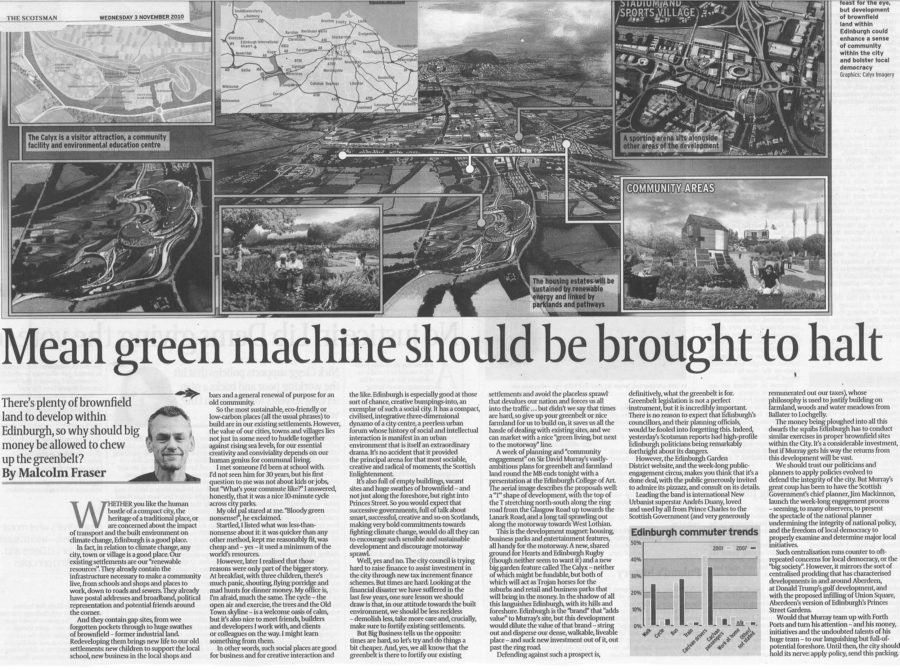Whether you like the human bustle of a compact city or the heritage of a traditional place, or are concerned about the impact of transport and the built environment on climate change, Edinburgh’s a good place.
In fact, in relation to climate change, any city, town or village is a good place. Our existing settlements are our “renewable resources”. They already contain the infrastructure necessary to make a community work, from schools and shops, and places to work, down to roads and sewers. They already have postal addresses and broadband, political representation and potential friends round the corner.
And they contain gap-sites, from wee forgotten pockets through to huge swathes of “brownfield” – ex-industrial land. Redeveloping them brings new life to our old settlements: new kids to support the local school, new business in the local shops and bars and a general renewal of purpose for an old community.
So the most “sustainable”, “eco-friendly” or “low-carbon” places (all the usual phrases) to build in, are in our existing settlements. But the value of our cities, towns and villages lies not just in some need to huddle together against rising sea levels, for our essential creativity and conviviality depends on our human genius for communal living.
I met someone who I’d been at school with. I’d not seen him for 30 years, but his first question to me was not about kids or jobs, but “What’s your commute like?” I answered, honestly, that it was a nice, 10 minute cycle across city parks. My old pal stared at me. “Bloody Green Nonsense!” he exclaimed. Startled, I listed what was less-than-nonsense about it: it was quicker than any other method, kept me reasonably-fit, was cheap and – yes – it used-up a minimum of the world’s resources.
But, later, I realised that those reasons were only part of the bigger story. At breakfast, with 3 kids, there’s much panic, shouting, flying porridge and mad hunts for dinner money. My office is, I’m afraid, much the same. The cycle – the open air and exercise, the trees and the Old Town skyline – is a welcome oasis of calm; but it’s also nice, and useful, to meet friends on the way, or builders and developers I work with and clients or colleagues. I might learn something from them.
In other words such social places are good for business, and creative interaction and the like. And Edinburgh is especially-good at those sort of chance, creative bumpings-into, an exemplar of such a social city. It has a compact, civilised, integrative 3-dimensionall dynamo of a city centre, a peerless urban forum whose history of social and intellectual interaction is manifest in an urban environment that is itself an extraordinary drama. It’s no accident that it provided the principal arena for that most sociable, creative and radical of moments, the Scottish Enlightenment.
And it’s also full of empty buildings, vacant sites and huge swathes of brownfield – and not just along the foreshore, but right into Princes Street. So you would expect that successive Governments, full of talk about smart, successful, creative and-so-on Scotlands, and making very bold commitments towards fighting climate change, would do all they can to encourage such sensible and sustainable development, and discourage motorway sprawl.
Well, yes and no. The City Council is trying hard to raise finance to assist investment in the city, through new “Tax Increment Finance” schemes. But times is hard. Looking at the financial disaster we have suffered in the last few years, one sure lesson we should draw is that, in our attitude towards the built environment, we should be less reckless – demolish less, take more care and, crucially, make sure to fortify existing settlements.
But Big Business tells us the opposite: times is hard, so let’s try and do things a bit cheaper, a bit worser. And, yes, we all know that the greenbelt is there to fortify our existing settlements, and avoid the placeless sprawl that devalues our nation and forces us all into the traffic… but didn’t we say that times is hard, so give up your greenbelt or nice farmland for us to build on, it saves us all the hassle of dealing with existing sites, and we can market some nice “green-living, but next to the motorway” line.
Publication / The Scotsman
Published in advance of a public presentation by Celebrity Urbanist Andrés Duany, who had been employed to – in this critic’s estimation – Prince-Charles-wash a massive busting of the Green Belt.
Unexpectedly, at the presentation, held in the main lecture theatre of the Edinburgh College of Art, Duany projected the piece on screen and spent some time talking about it, concluding that “I agree with everything Malcolm says, it’s just that that you can’t build family homes in the city” – a specifically American admission of urban failure, with cities presumably abandoned to the poor or the childless and gentrified.
Nine years later, after years of bludgeoning to support something that clearly is not in accord with policy, it seems the proposal is likely to go ahead.
A week of planning and “community engagement”, on Sir David Murray’s vastly-ambitious plans for greenbelt, and farmland land round the M8, ends tonight, with a presentation at the Edinburgh College of Art. The aerial image describes the proposals well: a “T” shape of development, with the top of the T stretching north-south along the ring road from the Glasgow Road up towards the Lanark Road, and a long tail sprawling out west along the motorway, towards West Lothian.
This is the development magnet: housing, business parks and entertainment features, all handy for the motorway. A new, shared ground for Hearts and Edinburgh Rugby (though neither seem to want it) and a new big garden feature called “The Calyx” – neither of which might be fundable, but both of which will act as Trojan horses for the suburbs and retail and business-parks that will bring-in the money. Behind, in the shadow of all this, languishes Edinburgh, with its hills and foreshore. Edinburgh is the “brand” that “adds value” to Murray’s site; but this development would dilute the value of that brand – string out and disperse our dense, walkable, liveable place – and suck new investment out of it, out past the ring road.
Defending against such a prospect is, definitively, what the greenbelt is for. Greenbelt legislation is not a perfect instrument, but it is incredibly important. There is no reason to expect that Ediburgh’s Councillors, and their Planning officials, would be fooled into forgetting this – and, indeed, yesterday’s Scotsman reports had significant Edinburgh politicians being remarkably-forthright about its dangers.
But the “Edinburgh Garden District” website, and the week-long public-engagement circus, makes you think that it’s a done-deal, with the public generously-invited to admire its pizzazz, and consult on its details. Leading the band is international “New Urbanist” superstar Andrés Duany, loved and used by all from Prince Charles to the Scottish Government (and very generously renumerated out our taxes), who’s philosophy and design “charette” methods are used to justify building on farmland, woods and watermeadows from Ballater to Lochgelly.
The money being ploughed-into all this utterly dwarfs the tiny squibs Edinburgh has, to conduct similar exercises in proper brownfield sites within the City. It’s a considerable investment; but if Murray gets his way the returns from this development will be vast.
We should trust our politicians and planners to apply policies evolved to defend the integrity of the City. But Murray’s great coup has been to have the Scottish Government’s Chief Planner, Jim Mackinnon, launch the week-long engagement process – seeming, to many observers, to present the spectable of the national planner undermining the integrity of national policy, and the freedom of local democracy to properly examine and determine major local initiatives. Such centralisation runs counter to off-repeated concerns for local democracy, or the “big society”. But it mirrors the sort of centralised-prodding that has characterised developments in and around Aberdeen, at Donald Trump’s golf development and with the proposed infilling of Union Square, Aberdeen’s version of Edinburgh’s Princes Street Gardens.
Would that Sir David Murray team-up with Forth Ports and turn his attention – and money and initiatives, and the undoubted talents of his huge team – to our languishing-but-full-of-potential foreshore. Until then the City shold hold its nerve: apply policy, send this packing.


